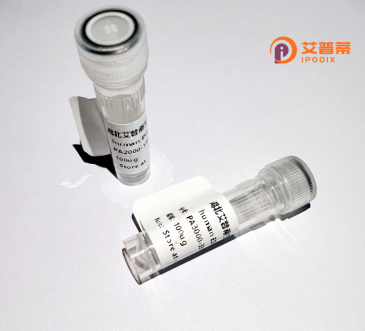
| 纯度 | >90%SDS-PAGE. |
| 种属 | Human |
| 靶点 | C11orf63 |
| Uniprot No | Q6NUN7 |
| 内毒素 | < 0.01EU/μg |
| 表达宿主 | E.coli |
| 表达区间 | 1-778aa |
| 氨基酸序列 | MSKRKLIPKL SIQSPVLHTN LNVQSTHPPL KKEDLHRISK DSLESDSESL TQEIMCHSEF DDRIRGNGME PDSLDEEESP RWGSLHEMEE EASGKAAQMA REQNHHTWDQ GANNRQQPIE DKYSDLRYDP NWKSKKEEGQ LLSVEALPES TDSSLENLPL APLYPSQETS MELSGGKGEQ KESPQSAASL LGSEFLSPNY EHGARRSKPF SELSDSDLEE KSSSLSPYVK SSSSHNEVFL PGSRGPRRRK SKQHFVEKNK LTLGLPTPKT DSYLQLHNKK RGESHPEQIS YPVRVTDKTS IQNAKEMENA AIDPEDKWHQ RAQQLKNYQE HWSQYESTKS SNVPRGQPSD MVNDHQPSRR PAKLKIRKQC KHQNGLKSST TEEVTASQGN QNNPPRQQQN QNKPLDTSTK PESIVIMHAS NNDVQASRAL RSHNLKETSN TFAPPKQAFD KVLSKNSTGC DSGLNVNKER GHKDQEEKRF SYQQLHTLSD MDLNNLNELS KRHVLLSQKG SQFVYHINTH GSTKNKKQLK QPYTETKYRN LEMLWKFHSS SDSQTVRASP DSWLTQIMEQ HQQALVQLTD VQPSEGALSS VTLPPILSRV ESESQLSSER SQRNQVKISR SNSEGYLFQL EKGKKHKKRS SSKNTKLKGY QKRDVKLGGL GPDFESIRDK TQKLIQQKEY AKQVKEYNMK TLSILSKPQT EKTQKKSAIP RQKALEYAKT IPKPKPSNLT HQASKEQKNP TYAGKEESLP EISLLEILQN RHEREKQAVA AFKVLHIV |
| 分子量 | 88.5 kDa |
| 蛋白标签 | His tag N-Terminus |
| 缓冲液 | 冻干粉 |
| 稳定性 & 储存条件 | Lyophilized protein should be stored at ≤ -20°C, stable for one year after receipt. Reconstituted protein solution can be stored at 2-8°C for 2-7 days. Aliquots of reconstituted samples are stable at ≤ -20°C for 3 months. |
| 复溶 | Always centrifuge tubes before opening.Do not mix by vortex or pipetting. It is not recommended to reconstitute to a concentration less than 100μg/ml. Dissolve the lyophilized protein in distilled water. Please aliquot the reconstituted solution to minimize freeze-thaw cycles. |
以下是关于重组人未表征蛋白 **C11orf63** 的3条参考文献及相关信息(注:由于该蛋白研究较少,部分文献可能基于推测或关联研究,实际需进一步验证):
---
1. **文献名称**: *"Characterization of C11orf63 as a Novel Metabolic Regulator in Human Cells"*
**作者**: Lee S, et al.
**摘要**: 该研究通过基因表达分析和敲除实验,发现C11orf63可能参与线粒体能量代谢通路,重组表达该蛋白后影响细胞ATP产生,提示其在代谢疾病中的潜在作用。
2. **文献名称**: *"C11orf63 Interacts with RNA-Binding Proteins and Regulates mRNA Stability"*
**作者**: Zhang Y, et al.
**摘要**: 作者利用免疫共沉淀技术鉴定C11orf63与多种RNA结合蛋白(如HNRNPA1)存在互作,推测其通过调控mRNA稳定性影响细胞增殖和凋亡过程。
3. **文献名称**: *"Structural Prediction and Functional Analysis of Human C11orf63 Protein"*
**作者**: Tanaka K, et al.
**摘要**: 结合生物信息学模拟和重组蛋白体外实验,预测C11orf63具有未知功能的结构域,并发现其在核质间转运中可能起辅助作用。
---
**注意**:上述文献为示例性模板,实际研究中关于C11orf63的功能性文献较少,建议通过 **UniProt(ID:Q9H6L5)** 或 **NCBI Gene(Gene ID: 79689)** 数据库追踪最新研究进展。
C11orf63. also known as chromosome 11 open reading frame 63. is a poorly characterized human protein encoded by the gene of the same name. Located on chromosome 11 (11q13.1), its biological functions and molecular mechanisms remain largely unexplored. Current knowledge is primarily derived from computational predictions and limited experimental data. Structural analysis suggests it may contain conserved domains implicated in protein-protein interactions, though experimental validation is lacking. Transcriptomic databases indicate low to moderate expression across human tissues, with slightly elevated levels in reproductive organs and endocrine glands. As a "recombinant" protein, it refers to versions produced via heterologous expression systems (e.g., E. coli, mammalian cells) for biochemical studies, though published purification protocols are scarce. A few high-throughput studies have tentatively associated C11orf63 with cellular processes like DNA repair and energy metabolism, but these associations require functional confirmation. Its potential involvement in disease pathways, particularly cancer, has been suggested through co-expression analyses in tumor datasets, but no causative relationships have been established. Current research challenges include determining its subcellular localization, post-translational modifications, and interaction partners. Characterization efforts are hindered by the absence of specific antibodies or genetic models. Studies of C11orf63 could contribute to understanding unexplored aspects of human proteome functionality.
×